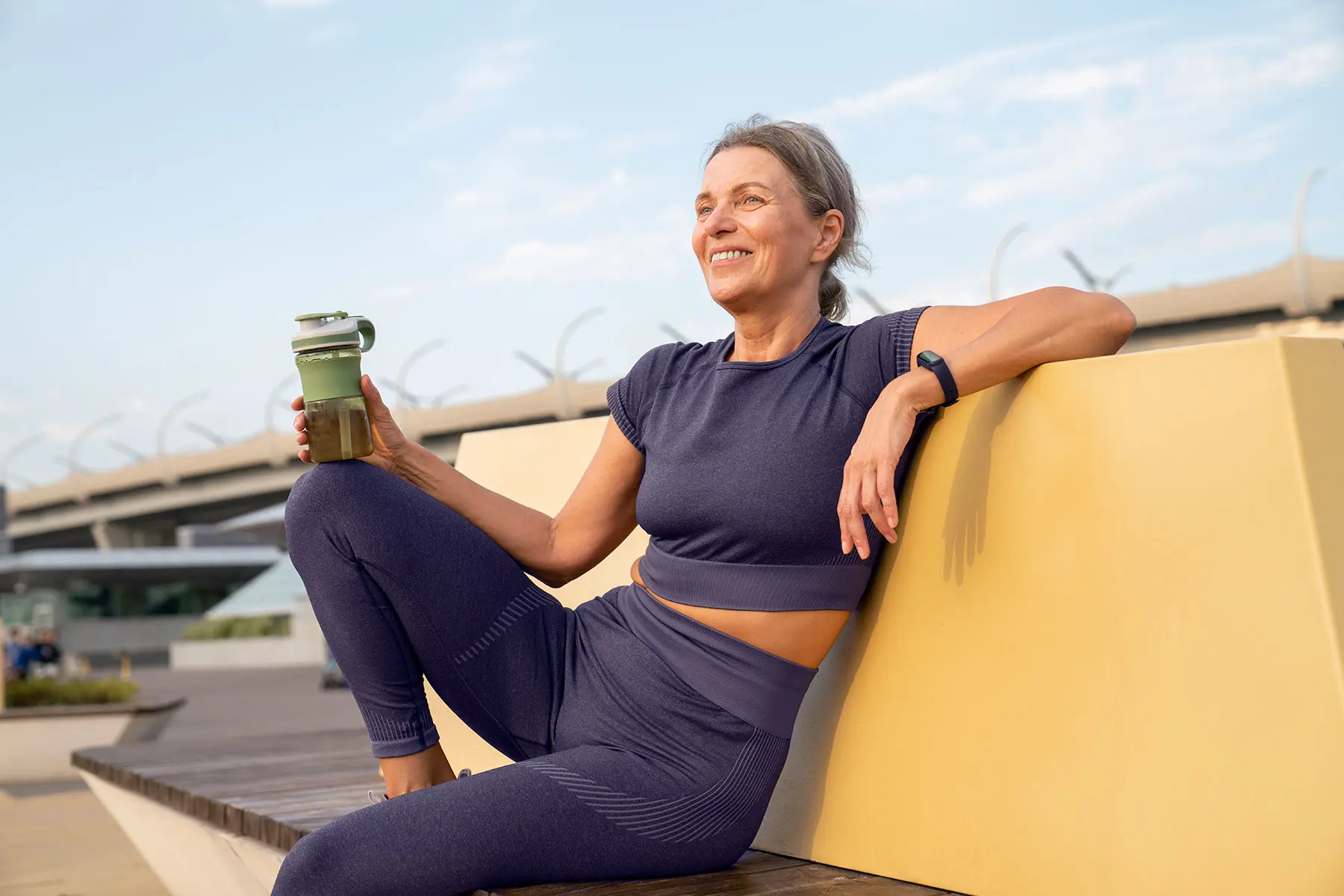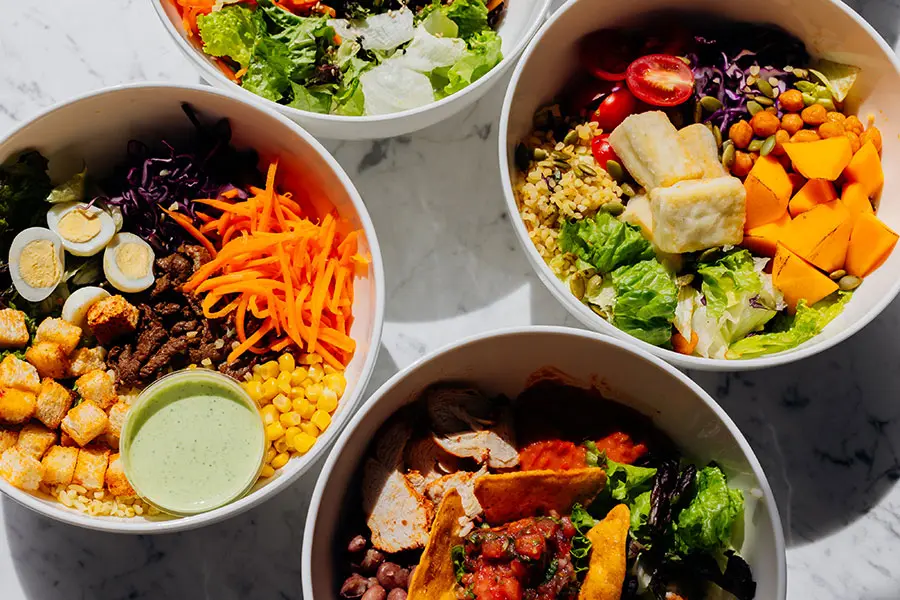
Welcome to Month 4 of your Alloy Weight Care program. You’ve spent 90 days reshaping your habits, your health, and your relationship with food. Now comes a new phase of your weight care journey: locking it in. This month, we’re focusing on muscle, metabolism, and mindset. Small shifts now will ensure that your results aren’t about a season—but last for a lifetime.
Let’s go deeper on the details this month: nutrient density, strength, and a mindset that sustains it all.
You’re Eating Less—So Nutrient Density Matters More
GLP-1 medications lower appetite, which can mean fewer calories and smaller portions. But your need for micronutrients doesn’t shrink just because your serving sizes do.
When you eat less food, you’re at higher risk for subtle nutrient gaps—especially in vitamins and minerals that power metabolism, protect bones, and regulate mood. Just one example: Women over 40 on GLP-1s who prioritized magnesium and vitamin D maintained more lean muscle mass than those who didn’t, in one recent study.
Six Micronutrients Women on GLP-1s Should Prioritize
Micronutrients are the essential vitamins and minerals that your body needs for growth, immune function, brain development, disease prevention, and overall well-being. To keep yourself healthy and feel your best, you need to include them in your diet.
Magnesium: Supports sleep, digestion, and stress regulation. Low intake is linked to fatigue and anxiety
Iron: Critical for energy and oxygen delivery. Deficiency can lead to brain fog, hair loss, and reduced exercise tolerance
B vitamins: Convert food into energy, help regulate hormones, and repair tissues
Zinc: Boosts immune function and supports thyroid health
Omega-3s: Reduce inflammation and help balance mood and metabolism
Vitamin D3 + K2: Work together to support calcium absorption and bone density

Dr. Montville’s Superfood Recommendations
You're eating less—but as a woman in (1) midlife and (2) on weight loss medication, your body is working harder than ever to adjust to hormonal shifts, muscle preservation, and metabolic recalibration. That’s why what you eat now matters so much.
Rather than overwhelm yourself trying to pack everything into every meal, focus on smart, strategic additions, such as packing homemade trail mix as a snack or swapping in one healthy ingredient when you cook. These micronutrient-dense foods are a great place to start.
Almonds A good source of magnesium, calcium and folate. Just one ounce of almonds meets most of the recommended daily amount of vitamin E.
Salmon & Sardines Salmon is full of omega-3 fatty acids, which support heart health, brain function, and healthy joints. Salmon, along with sardines and trout, tend to be lower in mercury than other types of seafood.
Beans Beans are a good source of thiamin, magnesium, iron, zinc, folate, phosphorus, and potassium. Try using beans in meals in place of higher fat proteins like meat. You’ll get a more well-rounded mixture of protein and micronutrients with less unhealthy saturated fat.
Spinach and other leafy vegetables Spinach has vitamins A and C, potassium, carotenoids, and folate, which support healthy vision, and cell function. Spinach, kale, and chard are all good sources of iron.
Broccoli Cruciferous vegetables like broccoli and cabbage have phytonutrients that are linked to immune health and detoxification. And broccoli is also a source of vitamin A (which supports healthy vision), vitamin C, and calcium.
Blueberries Packed with phytonutrients, which are linked to memory health. They also have vitamin K and manganese, which support your cells, blood flow, and calcium processing.
Sweet Potatoes A good source of potassium, vitamin A, and some B vitamins. Packed with beta carotene and fiber, which support healthy cell function.
Plus a few MVPs to experiment with…
Pumpkin seeds (pepitas) Excellent source of magnesium and potassium, which can lower blood sugar levels, regulate blood pressure, and improve bone strength. They’re also a rich source of zinc, for immune system function and bone health.
Nutritional yeast Loaded with B12 and protein. Adds a cheesy, savory flavor without dairy. Sprinkle on popcorn, over your salad, on top of roasted veggies, or mix into mashed avocado.
Hemp seeds Complete protein with all 9 amino acids—rare for a plant. Also high in magnesium and iron. A tasty way to try it: Add 2 tablespoons to a smoothie or sprinkle on eggs or oats.
Seaweed (nori, dulse, kelp flakes) Provides iodine (supports thyroid function) and calcium, nutrients that are often missing in midlife diets. Keep single-serve roasted nori snacks on hand or add flakes to salad dressings.
Tahini (sesame seed paste) Rich in calcium, magnesium, and B6. Plus, it’s easier to digest than whole nuts for some women on GLP-1s. Whisk into a simple dressing with lemon and water. Pour over steamed veggies or salmon.
Strength Training Anchors Long-Term Results
GLP-1s help you lose weight—but they don’t tell your body what to lose. Without resistance training, up to 25% of that weight loss may come from lean muscle. That’s not just an aesthetic issue—it impacts metabolism, strength, bone density, and long-term weight maintenance.
The solution? Strength training that is both intentional and progressively challenges your body.
This isn’t about becoming a bodybuilder. (You would have to devote yourself completely to working out and nutrition to become bulky or super-muscular.) It’s about preserving the muscle and bone tissue that keeps you upright, energized, and metabolically resilient for decades to come.
It’s Time To Up the Challenge

Reminder: You don’t need a gym membership or fancy gear. You just need consistency, enough resistance to stimulate muscle growth, and a plan for progressive overload—doing more over time so your muscles don’t adapt and plateau. Focus on these level-ups this month:
1. Move from light to moderate weights If a 3–5 lb dumbbell (or no dumbbell, or whatever you’re using) feels easy or you can complete your sets without feeling fatigue by the last couple of reps, then it’s time to push yourself. Upgrade to a weight where the final 2 reps feel challenging but doable.
2. Add time under tension Slow down each rep to increase muscle fiber recruitment. Try a 3-1-3 tempo: 3 seconds to lower, 1-second pause, 3 seconds to lift.
3. Increase frequency Bump up from 2 strength sessions per week to 3 or 4. Alternate upper and lower body days.
4. Add one more set If you’ve been doing 2 sets of each move, advance to 3. Aim for 8–12 reps per set with 60–90 seconds rest.
5. Incorporate bodyweight compound moves Push-ups, lunges, planks, and glute bridges can be done anywhere and recruit multiple muscles simultaneously, making them very efficient exercises. Add resistance bands or tempo changes to progress.
The Strength–Bone Density Connection
GLP-1s may increase bone turnover during rapid weight loss. Strength training counters that effect. Compound lifts like squats and deadlifts don’t just build muscle—they also improve bone mineral density at the spine and hips. A meta-analysis published in the American Journal of Physical Medicine & Rehabilitation found that resistance training significantly increased bone mineral density in the lumbar spine in all women in the study, and at the femur and radius in postmenopausal women.
Form Matters More Than Weight
Use a mirror to check alignment during squats and presses.
Brace your core (think: “abs engaged”) before lifting.
Rest 48 hours between working the same muscle group.
Exhale on your effort, inhale on the release.
Use Your Brain to Build Your Body: The Mind-Muscle Connection
Thinking about a muscle while you’re recruiting it makes it work harder. This internal focus during strength exercises (like visualizing your glutes contracting during a bridge) significantly increases muscle fiber recruitment. Even on low-energy days, this can elevate your workout.
How to Activate Mind-Muscle Focus
Name the muscle before each set. “This is for my back.” “Glutes on.”
Mentally cue the contraction. Think: squeeze, lift, hold, release.
Avoid distractions. Save the podcast for your walk. Use strength time as quiet focus time.
Calm Is a Muscle, Too
GLP-1s may reduce cravings, but you’ll need to find your own toolset to navigate emotional triggers, cortisol spikes, and the brain’s stress-eating pathways. This month, we’re doubling down on evidence-based mindfulness—not only for better vibes, but also for biology.
Why Mindfulness Is a Weight Loss Tool
Cortisol regulation: Chronic stress raises cortisol, which increases insulin resistance and belly fat. Mindfulness lowers baseline cortisol.
Improved sleep: Better sleep means better hunger/fullness hormone regulation.
Nervous system reset: Activates the parasympathetic system, reducing inflammation.
Tools That Actually Work

Try these this week, and throughout the month.
1. 5-Minute Body Scan Lie down, close your eyes, and slowly scan your body from feet to head.
2. Mindful Meals Eat one meal without screens. Smell, chew, pause. Listen for fullness cues.
3. 5-4-3-2-1 Grounding Look around, take a deep breath, and name 5 things you see, 4 you can touch, 3 you hear, 2 you smell, 1 you taste.
4. Visualization Picture your strongest self handling a hard day. Be specific with sights, sounds, and sensations.
5. Progressive Muscle Relaxation Tense each muscle group for 5–10 seconds, then release. Move head to toe.
You’re in the Zone…Let’s Keep The Momentum
After the first 90 days, many women are tempted to ease up. Research suggests this is due to a variety of factors, including a lack of support or frustration about progress.
Alloy is here to support you, so please know that your menopause-trained physician is always there to discuss ways she can help. And progress? We are all on different timelines, and dramatic body composition changes can take months, if not years. Focus on all the ways you’re already benefiting from your commitment: better sleep? More energy? Improved focus? Slow and steady—not sprinting—is the surest way to long-term success.
Also worth keeping in mind: As we lose weight, our body fights to return to its old “set point.” That’s a biological survival mechanism. Your job now is to make the new normal feel safe, repeatable, and supported. Keep showing up for your workouts. Keep reinforcing your new eating patterns. Keep in touch with your doctor. Keep choosing the strong path—even when it’s not perfect.
Your Month 4 Check-In
Pull out your S.M.A.R.T. goals and reassess them—because now is when long-term success gets built. Ask yourself:
Which habits feel locked in?
If you went on track, what strategies can you use to course correct this month?
Where are you still negotiating with yourself?
What surprised you about your body or mindset this month?
Have you lost weight and gained strength? Confidence? Calm?
Now it's time to double down and level-up. You’ve made progress; let’s make it permanent.
This week:
Check in with your Alloy provider.
Add one new strength challenge to your week. Do an extra day of training. Pick up a heavier weight. Increase your reps.
Choose one mindfulness tool and commit to using it daily. Five minutes is enough to shift your day.
Revisit your goals. Adjust if needed. But don’t pause. Momentum compounds.
We hope you’re feeling good about where you are now. Take a moment to celebrate your wins (big, small, and in-between) and appreciate your own agency and power on your weight care journey. In the coming month, you’ll see even more changes, and we’re here to lean on for guidance, support, encouragement—and anything else you need.
Sources:
https://www.cdc.gov/nutrition/features/micronutrient-facts.html
https://www.healthline.com/nutrition/11-benefits-of-pumpkin-seeds#easy-to-incorporate
https://health.ucdavis.edu/blog/good-food/top-15-healthy-foods-you-should-be-eating/2019/04
https://whenwomeninspire.com/2019/08/30/weight-lifting-form-vs-weight/
https://www.mayoclinic.org/healthy-lifestyle/fitness/in-depth/weight-training/art-20045842
https://my.clevelandclinic.org/health/articles/17450-rated-perceived-exertion-rpe-scale
https://pubmed.ncbi.nlm.nih.gov/26700744/
https://www.self.com/story/get-more-out-of-every-workout-mind-muscle-connection
https://www.calm.com/blog/visualization-meditation
https://www.therapistaid.com/therapy-article/grounding-techniques-article
Subscribe
Go ahead, you deserve to
feel fantastic
By subscribing you agree to our Terms of Service & Privacy Policy.